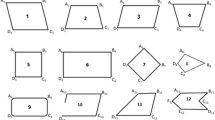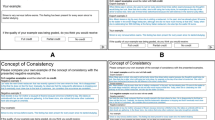Abstract
This paper reports on students’ conceptions of minima points. Written assignments and individual interviews uncovered salient, concept images, as well as erroneous mis-out examples that mistakenly regard examples as non-examples and mis-in examples that mistakenly grant non-examples the status of examples. We used Tall and Vinner’s theoretical framework to analyze the students’ errors that were rooted in mathematical and in real-life contexts.

Similar content being viewed by others
Data availability
The datasets are available from the corresponding author upon reasonable request.
References
Ayres, F., & Mendelson, E. (2012). Schaum’s outline of calculus (5th ed.). McGraw-Hill.
Bezuidenhout, J. (2001). Limits and continuity: Some conceptions of first-year students. International Journal of Mathematical Education in Science and Technology, 32, 487–500.
Bills, L., Dreyfus, T., Mason, J., Tsamir, P., Watson, A., & Zaslavsky, O. (2006). Exemplification in mathematics education. In J. Novotna, H. Moraova, M. Kratka, & N. Stehlikova (Eds.), Proceedings of the 30th PME International Conference (vol. 1, pp. 126–154). PME.
Biza, I. (2021). The discursive footprint of learning across mathematical domains: The case of the tangent line. The Journal of Mathematical Behavior, 62, 1–12. https://doi.org/10.1016/j.jmathb.2021.100870
Borasi, R. (1996). Reconceiving mathematics instruction: A focus on errors. Ablex.
Chick, H. (2009). Choice and use of examples as a window on mathematical knowledge for teaching. For the Learning of Mathematics, 29(3), 26–30 https://www.jstor.org/stable/25594563
Duru, A., Koklu, O., & Jakubowski, E. (2010). Pre-service mathematics teachers’ conceptions about the relationship between continuity and differentiability of a function. Scientific Research and Essays, 5, 1519–1529.
Fennema, E., Carpenter, T. P., Franke, M. L., Levi, L., Jacobs, V. R., & Empson, S. B. (1996). A longitudinal study of learning to use children’s thinking in mathematics instruction. Journal for Research in Mathematics Education, 27, 403–434.
Fischbein, E. (1987). Intuition in science and mathematics: An educational approach. Reidel.
Fujita, T. (2012). Learners’ level of understanding of the inclusion relations of quadrilaterals and prototype phenomenon. The Journal of Mathematical Behavior, 31, 60–72. https://doi.org/10.1016/j.jmathb.2011.08.003
Hill, H. C., Ball, D. L., & Schilling, S. G. (2008). Unpacking pedagogical content knowledge: Conceptualizing and measuring teachers’ topic-specific knowledge of students. Journal for Research in Mathematics Education, 39(4), 372–400. https://doi.org/10.5951/jresematheduc.39.4.0372
Juter, K. (2017). University students’ understandings of concept relations and preferred representations of continuity and differentiability. CERME10.
Leikin, R., Leikin, M., Waisman, I., & Shelley, S. (2013). Effect of the presence of external representations on accuracy and reaction time in solving mathematical double-choice problems by students of different levels of instruction. International Journal of Science and Mathematics Education, 11, 1049–1066. https://doi.org/10.1007/s10763-012-9389-1
Mason, J. (2006). Distinctive ontogeny: Ontological musings inspired by two discerning gentlemen of distinction(s), David Tall & Eddie Gray. In A. Simpson (Ed.), Retirement as process and concept: A Festschrift for Eddie Gray and David Tall (pp. 153–164). Charles University.
Mason, J., & Pimm, D. (1984). Generic examples: Seeing the general in the particular. Educational Studies in Mathematics, 15, 277–289. https://doi.org/10.1007/BF00312078
McGowen, M.A., & Tall, D. (2010). Metaphor or Met-Before? The effects of previous experience on practice and theory of learning mathematics. The Journal of Mathematical Behavior, 29, 169–179. https://doi.org/10.1016/j.jmathb.2010.08.002
Nardi, E. (2007). Amongst mathematicians: Teaching and learning mathematics at university level. Springer.
Ng, O. L. (2021). How ‘tall’ is the triangle? Constructionist learning of shape and space with 3D pens. International Journal of Mathematical Education in Science and Technology, 52, 1426–1432. https://doi.org/10.1080/0020739X.2020.1844910
Orhun, N. (2012). Graphical understanding in mathematics education: Derivative functions and students’ difficulties. Procedia - Social and Behavioral Sciences, 55, 679 – 684. https://doi.org/10.1016/j.sbspro.2012.09.551
Pape, S. J., & Tchoshanov, M. A. (2001). The role of representation in developing mathematical understanding. Theory Into Practice, 40, 117–127.
Petty, O., & Jansson, L. (1987). Sequencing examples and non-examples to facilitate concept attainment. Journal for Research in Mathematics Education, 18(2), 112–125.
Pimm, D. (1987). Speaking mathematically: Communication in mathematics classrooms. Routledge and Kegan Paul.
Ryan, J., & Williams, J. (2007). Children’s mathematics 4-15: Learning from errors and misconceptions. Open University Press, McGraw-Hill Education.
Santagata, R. (2005). Practices and beliefs in mistake-handling activities: A video study of Italian and US mathematics lessons. Teaching and Teacher Education, 21, 491–508.
Sierpińska, A. (1987). Humanities students and epistemological obstacles related to limits. Educational Studies in Mathematics, 18, 371–397. https://doi.org/10.1007/BF00240986
Shepherd, M. D., Selden, A., & Selden, J. (2012). University students’ reading of their first-year mathematics textbooks. Mathematical Thinking and Learning, 14(3), 226–256. https://doi.org/10.1080/10986065.2012.682959
Selden, A., & Selden, J. (2001). Tertiary mathematics education research and its future. In D. Holton (Ed.), The teaching and learning of mathematics at university level: An ICMI Study (pp. 237–254). Springer.
Sevimli, E. (2018). Understanding students’ hierarchical thinking: A view from continuity, differentiability and integrability. Teaching mathematics and its applications: An international journal of the IMA, 37, 1–16. https://doi.org/10.1093/teamat/hrw028
Stylianou, D. A. (2002). On the interaction of visualization and analysis: The negotiation of a visual representation in expert problem solving. The Journal of Mathematical Behavior, 21(3), 303–317. https://doi.org/10.1016/S0732-3123(02)00131-1
Tall, D. O. (1981). The transition to advanced mathematical thinking: Functions, limits, infinity and proof. In D. A. Grouws (Ed.), Handbook of Research on Mathematics Teaching and Learning (pp. 495–511). Macmillan.
Tall, D. O., & Vinner, S. (1981). Concept image and concept definition in mathematics, with particular reference to limits and continuity. Educational Studies in Mathematics, 12, 151–169. https://doi.org/10.1007/BF00305619
Thomas, G. B., Weir, M. D., Hass, J. R., & Giordano, F. R. (2004). Thomas’ calculus (11th ed.). Addison-Wesley.
Tirosh, D. (2000). Enhancing prospective teachers’ knowledge of children’s conceptions: The case of division of fractions. Journal for Research in Mathematics Education, 31(1), 5–25. https://doi.org/10.2307/749817
Tirosh, D., & Tsamir, P. (1996). The role of representations in students’ intuitive thinking about infinity. International Journal of Mathematical Education in Science and Technology, 27(1), 33–40. https://doi.org/10.1080/0020739960270105
Tirosh, D., & Tsamir, P. (2022). Mis-out and mis-in concept images of parallelograms: The case of Tal. International Journal of Science and Mathematics Education, 20, 981–997. https://doi.org/10.1007/s10763-021-10175-0
Tsamir, P., & Ovodenko, R. (2013). University students’ grasp of inflection points. Educational Studies in Mathematics, 83, 409–427. https://doi.org/10.1007/s10649-012-9463-1
Tsamir, P., & Tirosh, D. (2023). Mis-in and mis-out concept images: The case of even numbers. Educational Studies in Mathematics. https://doi.org/10.1007/s10649-022-10183-z
Tsamir, P., Tirosh, D., & Levenson, E. (2008). Intuitive nonexamples: The case of triangles. Educational Studies in Mathematics, 69, 81–95. https://doi.org/10.1007/s10649-008-9133-5
Ubuz, B. (2007). Interpreting a graph and constructing its derivative graph: Stability and change in students’ conceptions. International Journal of Mathematical Education in Science and Technology, 38(5), 609–637. https://doi.org/10.1080/00207390701359313
Ulusoy, F. (2021). Prospective early childhood and elementary school mathematics teachers’ concept images and concept definitions of triangles. International Journal of Science and Mathematics Education, 19, 1057–1078. https://doi.org/10.1007/s10763-020-10105-6
Vinner, S. (1990). Inconsistencies: Their causes and function in learning mathematics. Focus on Learning Problems in Mathematics, 12(3–4), 85–98.
Vinner, S. (1991). The role of definitions in the teaching and learning of mathematics. In D. O. Tall (Ed.), Advanced Mathematical Thinking (pp. 65–81). Kluwer.
Vinner, S., & Dreyfus, T. (1989). Images and definitions for the concept of function. Journal for Research in Mathematics Education, 20(4), 356–366.
Watson, A., & Mason, J. (2005). Mathematics as a constructive activity: Learners generating examples. Erlbaum.
Willingham, J. C., Strayer, J. F., Barlow, A. T., & Lischka, A. E. (2018). Examining mistakes to shift student thinking. Mathematics teaching in the middle school, 23, 324–332. https://doi.org/10.5951/mathteacmiddscho.23.6.0324
Zaslavsky, O., & Shir, K. (2005). Students’ conceptions of a mathematical definition. Journal for Research in Mathematics Education, 36(4), 317–346 http://www.jstor.org/stable/30035043
Zorich, V. A. (2004). Mathematical analysis I. Springer-Verlag.
Author information
Authors and Affiliations
Corresponding author
Ethics declarations
Competing interests
The authors declare no competing interests.
Additional information
Publisher’s note
Springer Nature remains neutral with regard to jurisdictional claims in published maps and institutional affiliations.
Rights and permissions
Springer Nature or its licensor (e.g. a society or other partner) holds exclusive rights to this article under a publishing agreement with the author(s) or other rightsholder(s); author self-archiving of the accepted manuscript version of this article is solely governed by the terms of such publishing agreement and applicable law.
About this article
Cite this article
Tsamir, P., Ovodenko, R. & Tirosh, D. Extrema points: concept images, mis-in and mis-out examples. Educ Stud Math 115, 13–33 (2024). https://doi.org/10.1007/s10649-023-10273-6
Accepted:
Published:
Issue Date:
DOI: https://doi.org/10.1007/s10649-023-10273-6




